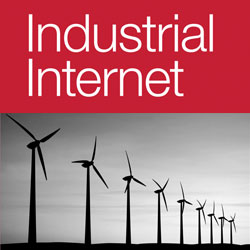O’Reilly has published a free e-book, “Industrial Internet,” (underwritten by GE, which, not so coincidentally, uses the industrial internet as the advertising slogan for its own involvement in the field…) about the “coming together to software and big machines.” It’s a great introduction to this crucial portion of the Internet of Things.
The message of the book? “With a network connection and an open interface that masks its underlying complexity, a machine becomes a Web service, ready to be coupled to software intelligence that can ingest broad context and optimize entire systems of machines.

“The industrial internet is this union of software and big machines… It promises to bring the key characteristics of the Web — modularity, abstraction, software above the level of a single device — to demanding physical settings, letting innovators break down big problems, solve them in small pieces, and then stitch together their solutions.”
Author Jon Bruner emphasizes that industrial internet devices don’t necessarily have to be connected to the public Internet: “…rather, it refers to machines becoming nodes on pervasive networks that use open protocols.”
Machines are reconceptualized as services, “…accessible to any authorized application that’s on the network. Those applications make it possible to simplify optimization of the physical devices without requiring as much knowledge. Most importantly, “…the industrial internet makes the physical world accessible to anyone who can recast its problems in terms that software can handle: learning, analysis, system-wide optimization. (my emphasis)”
Bruner points out that the bigger the network (think the entire US air traffic control system) the more optimized it can become. As Big Data takes over software intelligence “will become smarter and more granular.”
Hallmarks of the industrial internet will include:
- fewer, smarter machines
- less labor required to operate them
- “Any machine that registers state data can become a valuable sensor when it’s connected to a network.”
One point that really struck me was that physical products will be able to be improved on the fly, rather than just when a new model is introduced — think of what that means, in particular, for cars, which can often last up to 15 years: it will become possible to change engine settings simply by a software upgrade transmitter via a smartphone app!
“A software update might include a better algorithm for setting fuel-air mixtures that would improve fuel economy. Initiatives like OpenXC8, a Ford program that gives Android developers access to drivetrain data, portend the coming of ‘plug and play intelligence,’ in which a driver not only stocks his car with music and maps through his phone, but also provides his own software and computational power for the car’s drivetrain, updated as often as his phone. One driver might run software that adjusts the car’s driving characteristics for better fuel economy, another for sportier performance. That sort of customization might bring about a wide consumer market in machine controls.
“This could lead to the separation of markets in machines and in controls: buy a car from General Motors and buy the intelligent software to optimize it from Google. Manufacturers and software developers will need to think in terms of broad platforms to maximize the value of both their offerings.”
WOW!
The e-book includes a chapter on the crucial issue of security, arguing that, paradoxically, it may be easier to provide security on an Internet-based network — on the premise that the Internet is constantly challenged by hackers and constantly adapts — than on a more limited network. It mentions Shodan (I’ve been seeing a lot about that one recently!) and Basecamp2 as magnets that attract those who might want to hack the Internet of Things.
There’s also a chapter full of helpful case studies from pioneering industrial internet companies in fields including utilities, HVAC/building controls, automotive (I found that one particularly interesting), aviation, railroads (paradoxically, one of our oldest industries is among the most advanced in its use of sensors and other industrial internet technology, as I’ve reported previously), health care, and manufacturing. Any smart manager should get ideas for his or her company by reading them!
“Industrial Internet” is a must read! Download it today.
